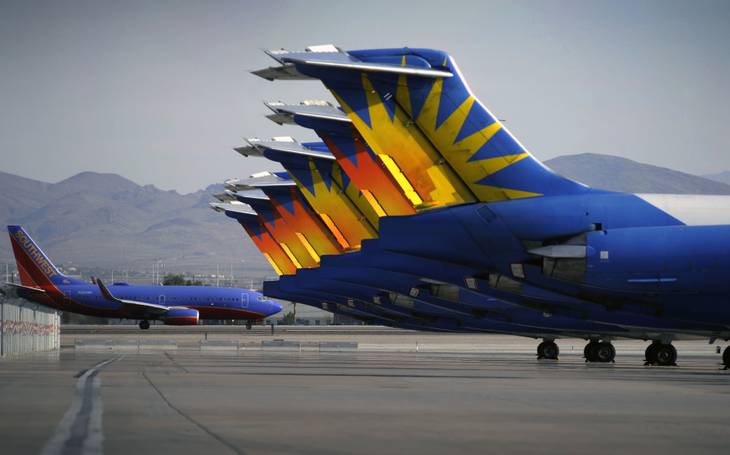Allegiant Air is a famously low-cost carrier: tickets are cheap, it grounds planes on light vacation-travel days and it's built a fleet with only used aircraft.
And lately, as oil prices plunged, it’s saved even more money.
The Las Vegas-based discount airline, profitable for more than 12 consecutive years, booked a record $65 million in net income in the first quarter, nearly double from a year earlier, despite only a 9 percent rise in revenue.
Profits soared in large part because of a steep drop in jet-fuel expenses, which fell to the lowest levels in years.
Airlines’ biggest expense is fuel, and Allegiant wasn’t alone in reaping the benefits of cheaper prices. Delta, United, Alaska and Southwest, by far the busiest airline at McCarran International Airport, also posted record profits.
“Everyone in the industry is really putting up record results,” said analyst Joe DeNardi, of Stifel Nicolaus.
Crude oil traded for about $45 to $55 per barrel in the first quarter, down from about $90 to $100 per barrel a year earlier. The drop came amid bloated supplies, thanks in part to increased fracking in the United States, and slumping demand globally.
The lower prices are unlikely to produce cheaper plane tickets, and airlines’ savings are poised to taper off this year because oil prices, though still relatively low, are up about 30 percent since mid-March.
But overall, cheaper fuel lets airline bosses acquire more planes, fly more routes, hire more personnel and pay off debts, industry advocates say.
Allegiant says it spent almost $70 million on fuel in the three months ended March 31, down 36 percent from a year earlier. It paid an average $1.93 per gallon, compared with $3.20 a year ago.
“It’s a nice savings,” Maurice “Maury” Gallagher, majority owner and CEO of parent Allegiant Travel Co., recently told analysts.
Allegiant, with about 75 planes in its fleet, is much smaller than powerhouse U.S. airlines — Delta, for instance, operates 786 planes and spent $1.8 billion on fuel in the first quarter.
But all things being equal, Allegiant was poised to save more money than its competitors as oil prices fell because of its fuel-purchasing strategy.
Allegiant only buys “spot” fuel, meaning it pays whatever price suppliers are charging that day. Other carriers do that too, but they also “hedge,” meaning they sign contracts to lock in prices for future deliveries.
Besides Allegiant, just one other major U.S. airline company only buys spot — American Airlines Group, parent of American and US Airways, said analyst Bob McAdoo, of Imperial Capital.
Both approaches have pros and cons. Hedging protects airlines against sudden price increases, though it makes them overpay if prices drop below what their contracts call for.
Buying spot lets Allegiant pay less when rates are low. But by not locking in certain prices, the company pays top dollar when they jump.
Allegiant has one way to limit the impact of rising oil prices, though: its planes spend a lot of time on the tarmac.
The company flies leisure travelers from small, underserved cities to Las Vegas and other warm-weather vacation spots. During slow vacation-travel days and seasons, Allegiant doesn’t fly nearly as often. Tuesdays are especially slow.
In Las Vegas, for instance, a popular weekend getaway, Allegiant’s planes are sometimes lined up wing-to-wing, idle, during the week. The airline had just nine scheduled arrivals to McCarran on Wednesday.
But as tourists start piling in here, Allegiant picks up the pace. It has 31 scheduled arrivals today.
Overall, Allegiant has at least some flights every day nationally, but at some point not long ago, “you’d have absolutely no flying” certain days, spokeswoman Jessica Wheeler said.
“Our whole model is designed around flexibility to meet demand,” she said.
Another reason Allegiant can ground planes is because of the relatively low cost to operate its fleet, which is made up entirely of previously owned aircraft.
Purchase prices are pretty cheap. Allegiant recently paid $30 million total for three Airbus planes — aircraft that sell new for $40 million apiece, analyst DeNardi said.
Allegiant’s planes, because they're older, don’t lose as much value as other carriers’ aircraft, he said. Also, because Allegiant is paying less, it's not under as much pressure to make money quickly by flying all the time.
“Allegiant’s business model lets them fly the planes only when they’re making money,” DeNardi said.
Meanwhile, Allegiant recently came close to saving a lot more on fuel — though it wouldn’t have been happy.
Its pilots’ union, Teamsters Local 1224, on April 1 called for the aviators to go on strike the next day. But hours later, a federal judge issued a temporary restraining order against the union, halting the plans.
The threatened walkout came amid protracted contract talks. Pilots alleged that Allegiant illegally replaced workplace rules and benefits while negotiating a collective bargaining agreement. Allegiant claimed a strike would be illegal, cost the airline millions of dollars per day and scare off customers.
On Friday, U.S. District Judge Andrew Gordon put a spike in the strike-that-never-was, granting Allegiant a preliminary injunction. In his order, Gordon wrote that “it would be unlawful for the pilots to strike at this point.”
The Teamsters plan to appeal.
